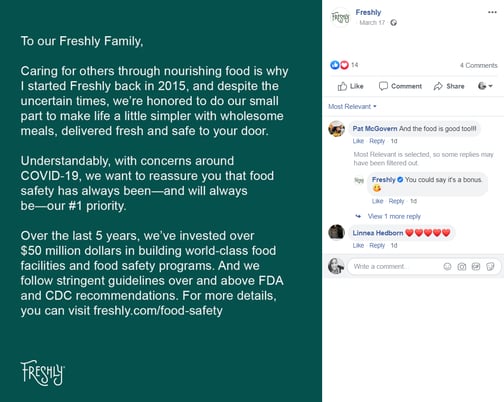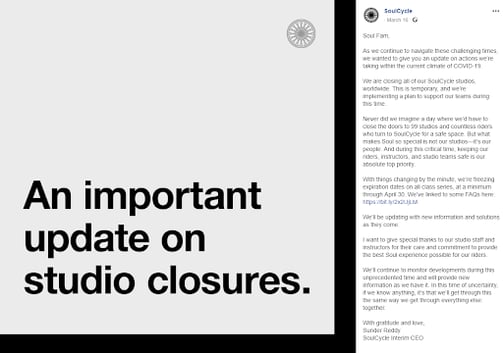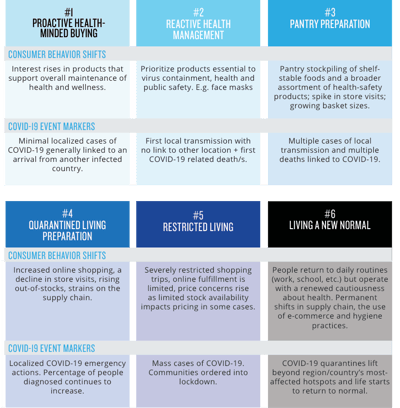.jpg?width=300&name=Header_COVID%20Customer%20Response%201200x627%20(2).jpg)
Responding On Social Media During Times of Crisis
The unprecedented situation caused by COVID-19 (Coronavirus) presents an unusual opportunity for companies to reinforce - or destroy - customer goodwill and brand perception. Listening to what customers are saying and responding appropriately is more important than ever. Yet doing so effectively is challenging.
In light of the uncertainty caused by the ongoing COVID-19 (Coronavirus) global crisis, brands and businesses everywhere are having to adjust to a new normal. Businesses that rely on brick-and-mortar channels are forced to temporarily close those channels and move to digital channels instead. Even online-first delivery businesses are forced to cope with increased demand and intense customer scrutiny on how they are ensuring health and safety even as they continue making deliveries.
At BrandBastion, we’ve spent the past 6 years helping brands respond to customers at scale on social media. We’ve seen that clear, consistent, and timely communication makes a huge difference in turning around crisis situations.
To help brands manage the increased levels of engagement and inquiries that many are currently experiencing on social media, we decided to compile a resource of some key learnings and tips we have acquired through our experience of working with top global brands during times of change and unpredictability.
This article will outline some considerations it’s important to keep in mind when engaging with customers during a crisis. We also added some practical, actionable tips that you can immediately start implementing in your team within the next 24 hours.
5 Considerations for Brands Dealing With A Crisis Situation on Social Media
1. In uncharted territory, prompt and consistent communication is important.
Operating in times of crisis requires acknowledging there is no “perfect solution” for coping with increased customer inquiries, increased demand, supply shortages, and increased public scrutiny.
It is important to be strategic and take enough time to plan and prepare instead of reacting haphazardly. Yet, it is also important to not let too much time go by before responding to customers who are waiting to hear from you. Each day that goes by without responding to customer questions is another day of frustrated customers, decreased loyalty, and lost sales.
Also, it is also important to react consistently and in a structured way. In a crisis, having individual community managers or agents respond in different ways creates the risk that due to a lack of training, different individuals may handle the same situation very differently, confusing and alienating customers as a result.
When customers are asking for information on a widespread crisis, it’s important to deliver a structured corporate response. It is also best if the response is from the top leadership of the company, and it should involve the following:
- Acknowledging the challenges of the current situation.
- Thanking customers for their support so far.
- Setting reasonable and specific expectations such as any estimated timeframes for delays. You should also include anticipated disruptions in service, and so on.
- Explaining what steps you are taking to address the situation.
- Reinforcing your commitment to your customers.
You can deliver this response as a press release, a website announcement, and/or an email blast to all customers. The core of the message can then be simplified and condensed for social media posts. You can also link to the core message in social media replies to people who are asking questions on the topic.
Examples of social media announcements on Covid-19 from food delivery company Freshly and fitness studio SoulCycle:


At BrandBastion, we’ve worked with global brands and seen results such as one major brand achieved - a 74% decrease in customer questions around a sensitive topic, a 43% decrease in negative sentiment, and a 269% increase in positive sentiment, simply by having a proactive and structured response approach in place. By monitoring and tracking all comments related to the topic, and responding actively with more information on its policies, this brand was able to prevent false claims and brand attacks from escalating.
2. Be human, but prioritize your customers based on importance and profitability.
Not all questions and comments are equal. When you’re inundated with high volumes of comments and have limited time and resources to attend to everything, it’s important to prioritize based on importance and profitability.
Retaining existing customers and keeping them happy should be of top priority. The next line is helping prospects get the information they need to become customers. Lastly, you can respond to all other general inquiries.
When you are determining what to assign time and effort into addressing on social media, the questions and complaints from existing customers with existing orders or purchases should take the highest priority. The focus should be on directing such customers to relevant information by sharing links or on connecting them to a human who can help them troubleshoot their issues.
Below are some examples of comments from existing customers expressing that they need help with or are dissatisfied with a recent purchase:
“Will my items still be received on time? They say they have been shipped, but not out for delivery.”
“Very misleading offer. My son ordered and he won’t get the discount unless I sign up. That's not right.”
“Can I extend my membership since you guys closed your studios?”
The second highest priority should be handling inquiries from potential new customers. Changes in the status quo always present opportunities to win over new customers. Yet, to seize this opportunity, brands should be ready to respond to prospects' questions with the right information. You should also be ready to point them to the right channels to make a purchase.
Below are some examples of comments from potential customers who are expressing their interest to buy, but need more information to make their decision:
“What kind of extra precautions are you taking to ensure the people handling the shipping from start to delivery are COVID-19 free? Thank you. Very concerned.”
“I wish there was an option to order this gluten-free! Will you be introducing options for the gluten-intolerant people out there?”
"Are you going to be able to continue the service during the current situation?”
"Do y’all do online classes? I’d pay to do it online. 🤷🏻♀️"
While it’s important to respond to as many customer inquiries as possible, when dealing with high volumes of engagement, it’s most important to first preserve the loyalty of existing customers to retain them and continue to win their business when things stabilize.
3. Use this as an opportunity to leverage new channels.
While you may have been primarily engaging on the major platforms like Facebook, Instagram, and Twitter, the increased engagement across the board is a good opportunity to build and engage with an audience across other channels you’ve been meaning to test out but haven’t yet.
Beyond your core social media pages, this could be a good time to explore new social messaging platforms. For instance, allowing customers to message you for support on Facebook Messenger or WhatsApp for Business will facilitate a more conversational engagement to deliver fast, effective, and reassuring communication to your audience. You should also consider automating your chat flows to manage engagement especially in relation to the FAQs that people might have about their relationship with your business.
Live Streaming announcements on business changes via Facebook Watch Party, IG Live, Twitter Live, or Youtube Live might unlock new levels of engagement from your audience especially now that many people are staying back at home and spending more time online. 47%t of consumers globally increased their live streaming in 2018. Cisco’s Annual Internet Report estimates that 82% of all internet traffic will be video by 2022. And Facebook says its users are 4X more likely to watch a live stream than to watch a recorded video.
If your business demographics cater to a younger audience, you may also want to explore setting up a presence on TikTok. The new social media platform now has more than 500 million active users worldwide. Also, about 50% of its users are under 34 years old and as much as 41% of its users are between 16 and 24 years old.
4. Reconsider your definition of success.
In uncharted territory, retaining the same metrics of success as you would in a business-as-usual situation can be damaging to business in more ways than one.
Firstly, if your team believes that they need to hit the same targets set before the crisis started, they could inadvertently continue to prioritize the wrong things. For instance, old KPIs tied to driving new sales might be pursued at the cost of neglecting customers who need help. Also, the focus on driving new sales might make it harder to efficiently fulfill existing orders that have already been committed to especially if those customers need new accommodations such as faster deliveries or bundled deliveries because of the crisis.
Secondly, continuing with sales and promotional campaigns as per business-as-usual when your customers are going through a difficult time may at times suggest a lack of empathy. People want a message of positivity, empathy, and hope and this is not the time to aggressively push to close more sales and attract new leads. Aggressive sales and marketing campaigns during a crisis can at worst be seen as tone-deaf, which may alienate customers who may consider your brand to be soulless and hesitate to buy from you in the future.
The brands that are likely to emerge stronger and more loved from this crisis are brands that during these unusual times, redefine success in terms of human impact in addition to revenue and profits. Brands should also look for and document success on actions they are taking to make the lives of employees easier. Success during these times can also be tied to the concrete number on the lives your brand can touch by going out of your way to ameliorate the situation through price cuts, discounts, and freebies.
5. Understand the different consumer behavior thresholds of concern among customers.
In early March 2020, Nielsen published an article outlining six consumer behavior thresholds that will emerge as Covid-19 evolves. These thresholds came from an analysis of public health information. The data was then correlated with consumer spending data to detect a series of recurring patterns that emerged from the data.
Understanding these thresholds across the impacted countries can help businesses and retailers know what to prepare for as they face supply issues and the race to meet record levels of demand and changing purchase behavior.
These six thresholds are outlined in the graphic below:

Source: Nielsen, March 2020. Key Consumer Behavior Thresholds Identified As the Coronavirus Outbreak Evolves
When it comes to communicating with customers on social media, taking into account the above thresholds can help in formulating a response strategy and what to say to customers. You'll be able to improve on how you inform them about delivery delays. It will also help in communicating about dates when certain products will be restocked. You can also leverage it when recommending product substitutions in times of supply shortages. Knowing what is likely to be top of mind for your consumers helps in responding appropriately.
5 Quick Tips to Respond Efficiently At Scale In A Crisis
1. Align all externally-facing teams
During a crisis, it’s important to ensure all externally-facing teams (marketing, customer service, and communications) are aligned on the company’s messaging strategy. They should also be abreast of any new company policies that may need to be introduced during this time. It doesn't matter if it’s a press release, a reply to a customer comment on social media, or a remote human agent handling a customer ticket. All responses to the public and your customers must be clear and consistent to reinforce trust and preserve brand equity.
Customers are a lot more likely to be understanding of an extended delay if the delay is justified and explained in clear terms. In contrast, radio silence or conflicting information coming from a brand can make customers livid.
2. Set up a page on your company website that can serve as a central source of truth
When a crisis interrupts standard business operations, people will want to get the most up-to-date information from you. It is in a brand’s best interest to set up a page on the company website that provides a single source of truth on how the crisis affects the business and relationships with its customers.
As an example, in recent weeks, many airlines have started setting up pages to provide live updates on the business situation with flight cancellations and updates to flight change policies. More importantly, the source of truth needs to be updated with information as the situation changes.
If you don’t proactively provide an official source of truth, this increases the risk of speculation and fake news to be spread on social media.
3. Set up a system to triage and prioritize incoming inquiries
In a crisis, high volumes of customer inquiries may overload the existing set up you have to handle them. It’s important to plan towards temporarily setting up a new system to triage and prioritize.
It may no longer be possible to respond to every comment or have the same 5-minute turnaround time for every ticket. In such a situation, it’s crucial to channel the resources you have available into the most important and profitable inquiries.
For instance, you should identify comments from existing customers with a specific issue with their order and channel them to a place where they can get 1-on-1 help.
You can respond to broad questions about how your business is adapting, responding to, or addressing the crisis with templates. At BrandBastion, we recommend proactively defining up to 30 variations of responses for a specific set of recurring questions. This way, it’s easier for your team (or using automation) to pick from a bucket of pre-drafted responses and issue it as scale, without sounding robotic.
4. Turn on Auto Responses on Facebook Messenger
During a crisis, there will be a spike in the number of people reaching out to you for information. If you have Messaging turned on for your business’ Facebook Page, you may experience an influx of private messages. However, your customer care team might find it hard to keep up with every message. In such cases, brands can turn on automated responses on Facebook Messenger to improve their response times. The quick auto-response will also reassure your audience that their messages will get a response eventually. Doing this will manage the workload of your team, and prevent your audiences from ending up frustrated because of radio silence.
The best practice is to draft and set up an automated message that acknowledges that during this exceptional situation, you are receiving high levels of inquiries. The message should also set expectations of when customers can expect to hear from you.
5. Use listening tools to monitor the situation and adjust your response strategy as the situation evolves
A global crisis such as the current Covid-19 pandemic is rarely static. The situation is in a state of constant flux and it might be hard to manually track the developments to keep your public engagement updated. You can leverage social listening tools to track topical chatter. For example, in the current situation, tracking keywords such as Covid or Coronavirus could help you stay on top of the news. It's important to not only track the volume of chatter but also to note the nature and sentiment of that chatter.
Monitoring volumes and sentiment can help you to understand public perception. It also helps in knowing whether your audience thinks your brand is handling the situation well or not. Also, these insights should be shared with customer service and leadership teams. Note that delivering customer satisfaction and building brand affinity in challenging times is not only a matter of communication. It is also dependent on the quality of the whole buying and customer service experience.
